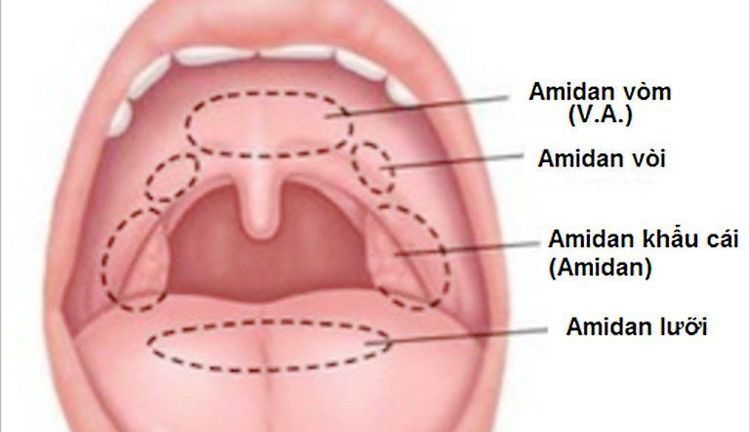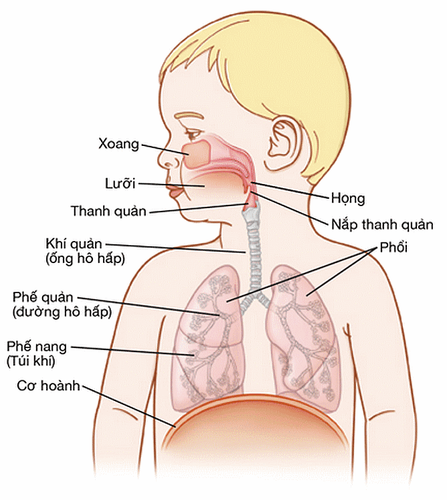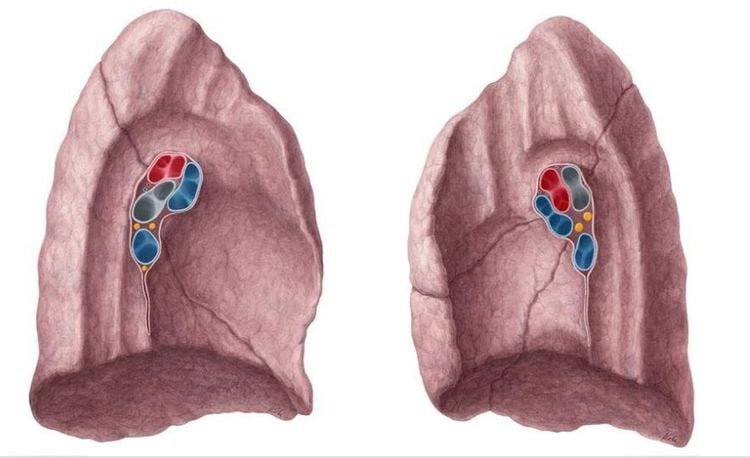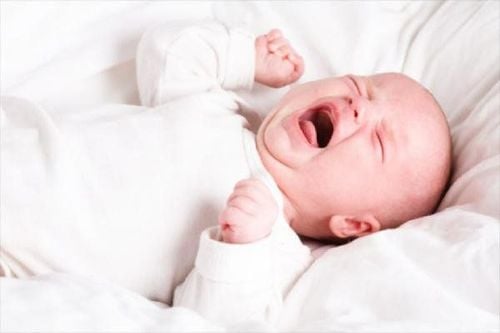This is an automatically translated article.
The article was written by MSc Ma Van Tham - Internal Medicine Doctor, Department of Pediatrics - Neonatology - Vinmec Phu Quoc International General Hospital.The respiratory system includes: nose, pharynx, pharynx, larynx, trachea, bronchi, lungs, thorax and respiratory muscles. The respiratory center and nerve transmitters together play an important role in the respiratory system.
1. Anatomical and structural features
1.1. Nose Children: the nostrils and nasal passages are narrow, the pharyngeal cavity is small and short. As a result, the inhaled air is not sufficiently filtered and heated. The nasal mucosa is soft, with many blood vessels, so it is easy to be injured and scratched, causing bleeding. The function of the nasal mucosal barrier is poor, due to the poor antiseptic ability of the mucus, so the child's nose is susceptible to infection. Cavernous organization in the submucosal layer: in young children, it is less developed, but from 5 years old to puberty, it develops strongly. So children are prone to nosebleeds. At birth, the maxillary sinus is present, while the ethmoid sinus does not develop clearly until 2 years of age. The frontal and sphenoid sinuses develop from 2 years of age until puberty. Therefore, infants and young children are less likely to have inflammation that spreads to the sinuses. 1.2. Throat, pharynx Narrow, short with vertical direction. Funnel-shaped, soft and smooth cartilage. The pharynx thrives during the first year of life and puberty. In children under 3 years of age: the throat of boys and girls is the same length, from 3 years of age onwards, the throat of boys is longer than that of girls. Waldayer lymphatic ring: thrives at 4-6 years of age until puberty. In children under 1 year old, the lymphatic system is less developed, usually only V.A develops, but no development of the palatine tonsils is seen. From 2 years of age and older, the palatal tonsils are well developed and can be seen.

Hình ảnh mô tả vòng bạch huyết Waldayer
1.3. Tracheostomy 1.3.1. Larynx Funnel-shaped, extending above, in breastfed infants: the larynx is located 2 vertebrae higher than in adults. The larynx develops slowly, and it is not until puberty that it develops strongly. Under 6-7 years old: narrow vocal fissure, short vocal cords. Hence children's voices are higher. From the age of 12 onwards, boys' vocal cords are longer than girls' voices, so boys' voices are deeper. 1.3.2. Trachea The trachea in children under 6 months is funnel-shaped. Newborn baby's trachea is 4cm long and 0.5cm wide. Children under 5 years old are 5.5cm long, 0.7cm wide. The mucosa of the trachea is smooth, vascular, and relatively dry because the glands of the mucosa are underdeveloped. Tracheal cartilage is soft, easy to stretch. 1.3.3. Bronchi: Location of tracheal bifurcation: + Newborn: III - IV
dorsal vertebrae + Children 2 - 6 years old: IV - V
dorsal vertebra + 12 years old: V - VI
bronchial branch must be wide and continue straight in the direction of the trachea, so the foreign body is easier to fall in.
1.3.4. General characteristics laryngotracheobronchial and laryngotracheobronchitis in children Relatively narrow heart Elastic organization is underdeveloped Soft cartilage ring, easy to deform The mucosa has many blood vessels Due to the above characteristics, children are prone to infections of the respiratory tract and mucous membranes. The laryngotracheal mucosa is prone to edema, exudation and deformation during the pathological process.
1.4. Lung Structural features of children's lungs have important implications for respiratory pathology. The development of children's lungs is divided into two processes: increase in lung volume and respiratory area and differentiation of lung tissues.

Vị trí và cấu tạo của phổi thuộc hệ hô hấp ở trẻ nhỏ
1.4.1. Children's lungs grow with age * Child's lung weight
Newborn: 50 - 60g (about 1/34 - 1/54 of baby's body weight) 6 months old: 3 times more than at birth Child 12 age: 10 times more than at birth Adults: 20 times heavier than a newborn's lungs * Children's lung volume: increases very rapidly during development.
Newborns: 65 - 67 ml Children 12 years old: 10 times more than at birth * Alveolar size: increasing gradually with age.
Newborns: 0.05 - 0.07 mm Children 5 - 7 years old: 0.12 mm Children 12 - 15: 0.17 mm Adults: 0.20 mm Therefore the respiratory area also increases: infants birth 6m2, adult 50m2.
1.4.2. In terms of structure Basic structural unit: alveolar sac (Acini), each alveolus consists of about 20 - 25 alveoli and bronchioles. Lung development from birth to 8 years of age is mainly due to an increase in the number of alveoli, while in the later period increases in the size of the alveoli. Children's lungs are less elastic, so they are prone to atelectasis, emphysema, alveolar dilatation when pneumonia, pertussis occurs. Children's lungs, especially young children, have many blood vessels, lymphatic vessels and fibers. smooth muscle. Therefore, children's lungs have a great capacity to contract and reabsorb fluid in the alveoli faster. The interlobar fissure is not obvious in young children, the right lung has 2 grooves, the left lung has 1 groove. These grooves will gradually become clearer and deeper. 1.4.3. The hilum Consists of the main bronchus, nerves, blood vessels, and lymph nodes. These nodes are related to other lymph nodes in the lungs. Therefore, any inflammatory process in the lungs can cause a reaction to the hilar nodes. The right hilum is higher than the left lung hilum (the right hilum is level with D5 - D6, and the left hilum is at a level with D6 - D7). Lymph nodes in hilar lung: + Including: group of trachea, trachea, bronchopulmonary system, where the trachea bifurcates. very susceptible to infection.

Hình ảnh vị trí của rốn phổi
1.6. Chest The shape and structure of a child's ribcage changes with age and has the following characteristics:
Newborns: short, cylindrical ribcage. The front and rear diameter is equal to the horizontal diameter. The ribs are horizontal and perpendicular to the spine. The diaphragm is located high, the intercostal muscles are not fully developed. When the child learns to walk: The thorax changes (flattened), the transverse diameter is 2 times larger than the anterior posterior diameter. The ribs are inclined downward, the diaphragm descends, the intercostal muscles, the thoracic muscles develop gradually. Thoracic development also depends on the health status, especially the exercise of the child, as well as on the medical condition, especially rickets, which will affect the development of the chest.
Children need to provide enough elemental zinc/day for them to eat well, reach the correct height and weight and exceed the standard. Zinc plays a role in affecting most biological processes taking place in the body, especially the breakdown of nucleic acids, proteins... Organs in the body when zinc deficiency can lead to a There are a number of diseases such as neurological disorders, irritability, etc. Therefore, parents need to learn about the role of zinc and guide them to appropriate zinc supplements for their children.
In addition to zinc, parents also need to supplement their children with other important vitamins and minerals such as lysine, chromium, B vitamins,... errands.
>> Read more: Children's respiratory system characteristics - Part 2
Please regularly visit Vinmec.com website and update useful information to take care of your baby and the whole family.














